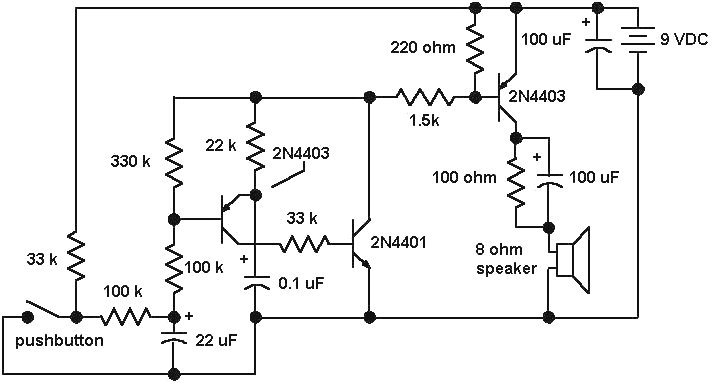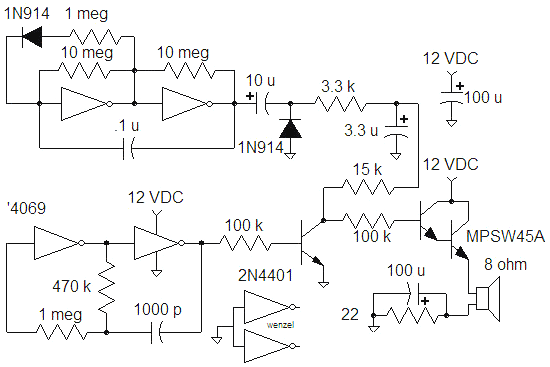

![]()
This siren circuit simulates police, fire or other emergency sirens that produce an up and down wail.

The heart of the circuit is the two transistor flasher with frequency modulation applied to the base of the first transistor. When the pushbutton is depressed, the frequency of oscillation climbs to a peak and when the button is released, the frequency descends due to the rising and falling voltage on the 22 uF capacitor. The rate of change is determined by the capacitor value and the 100k resistor from the pushbutton. The oscillation eventually stops if the button is not depressed and the current consumption drops to a tiny level so no power switch is needed.
The 0.1 uF determines the pitch of the siren: A 0.047uF will give a higher pitch siren and a 0.001 uF will give an ultrasonic (at least for me, anyway) siren from 15 to 30 kHz which might have an interesting effect on the neighborhood dogs! The 33k resistor from the collector of the PNP to the base of the NPN widens the pulse to the speaker giving greater volume.
The flasher circuit drives a PNP transistor which powers the speaker. This transistor may be a small-signal transistor like the 2N4403 in most applications since it will not dissipate much power thanks to the rapid on-and-off switching. The 100 ohm and 100uF capacitor in series with the speaker limit the current to about 60 mA and they may be replaced with a short circuit for a louder siren as long as the transistor can take the increased current. The prototype drew about 120 mA when shorted which is fine for the 2N4403.
Transistor substitutions should be fine - try just about any small-signal transistors but avoid high frequency types so that you do not end up with unwanted RF oscillations.
![]()
This circuit simulates a chime similar to the sound many cars make when the keys are left in the ignition. The bottom two gates form a squarewave audio oscillator that drives the base of the 2N4401, turning it on and off at an audio rate. The top two gates produce a short low-going pulse about once per second that discharges the 10 uF capacitor through the diode. The voltage then jumps up and slowly decays through the 15 k collector resistor when the 2N4401 is conducting. The result is a squarewave on the collector of the 2N4401 that jumps up quickly then decays slowly. The darlington emitter-follower buffers the squarewave and drives a small speaker.

The tone frequency is set by the 1000 pF capacitor and the cadence of the chime is set by the 0.1 uF capacitor. The 10 uF capacitor determines how quickly the chime dies out and the 3.3 k/3.3 uF soften the attack time of the leading edge of the chime. The volume is set by the 22 ohm resistor and 100 uF bypass capacitor. These values may be experimentally varied to produce the desired sound.